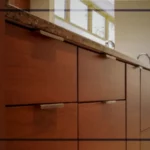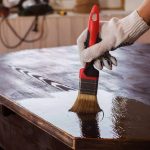How to Apply Polyurethane With Rag? 7 Easy Steps!
There are many ways to apply polyurethane on a wooden surface. People mostly use roller, brushes, and spray. But the question is, can you apply polyurethane with a rag? If yes, then what is the process?
Yes, you can use a rag to apply polyurethane. First, you have to prepare yourself and the surface. Mix the spirit with polyurethane if it is thick. Then, apply polyurethane with an unused rag in every part. Remove excess urethane after half an hour. Let it dry for 4 to 6 hours. Then sand the surface and apply another coat.
The process is simple to apply. But there are a lot of little things to consider while applying. In this article, a detailed discussion of the process is given with many tips. Stay here to get a better idea about the process without any doubt.
Can You Apply Polyurethane With A Rag?
Yes, you can apply polyurethane with a rag. While applying a rag, you can wipe the surface according to your wish. You can easily spread it or also can remove excess polyurethane while applying.
In every stroke, you will get a thin coating with full coverage with a rag. A rag can save polyurethane as it absorbs little and not as much as a brush.
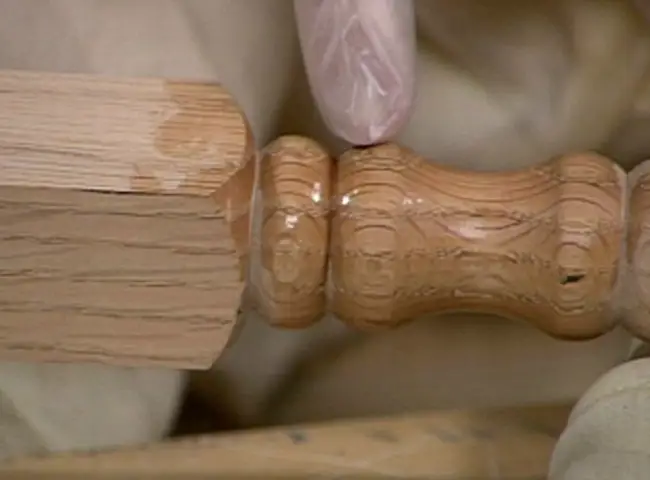
Before using the rag, you should be careful about some factors. The rag should be free from lint. Avoid fluffy rags. Because while applying, the lint can get stuck on the surface and hamper getting a smooth finishing.
Also, the rag should be clean and unused. A microfiber cloth would be the best option if you want to avoid a lint-free cloth.
7 Steps To Apply Oil-Based Polyurethane With Rag
Polyurethane gives protection to the wood by working as a coating. For indoor furniture, it is the best option. Mostly, the wood exposed to heat and pressure is greatly protected by its coating.

But, you have to ensure an effective finish to get the highest level of protection to the wooden surfaces. Follow the given steps to give a good finish to your wooden materials.
Step 1: Personal Protection
Polyurethane causes many health hazards to people who have prolonged exposure to the released irritant fume. So, you should wear a mask to save yourself from inhaling the gas.
Also, while polyurethane comes in contact with our skin, it gets absorbed. So, be sure to wear gloves because the whole process will be performed by your hand.
Work in an open or ventilated place. A closed room can cause breathing problems due to the bad odor of polyurethane.
Step 2: Preparations
You have to prepare the wooden surface before you are going to apply the polyurethane. Apply mineral spirit on the surface for better results. Leave the wood for about 1 to 2 hours for proper drying.
Now use good quality or fine grit sandpaper like 100, 120, 220, 320, 500, or 1000 grit. Among those 80 grit is good for a new or unused wood. Using sandpaper improves coating performance by softening the surface. In this process, dust and debris are also removed and ultimately, the surface becomes even.
Also, make sure that there should be sufficient airflow for the drying process. Never work around a fire, as polyurethane easily catches it.
Step 3: Mixing Spirit
Now, you have to make the polyurethane thin enough to apply on the surface. A thick liquid can make the coating hard and increase the risk of cracks. If your purchasing polyurethane is thick, then take three-fourths of urethane in a container.
Now add one-fourth of spirit into it and mix well. But if the purchasing polyurethane is thin, then you need not follow this step. Skip this and go to the next step.
Step 4: Applying Polyurethane
Now, pour the polyurethane on the wooden surface. Or you can dip the rag in the polyurethane. Now wipe the polyurethane properly on the surface. Do not leave any area untouched. Wipe every area twice so that the surface gets full coverage.
Step 5: Drying and Remove Excess Polyurethane
Now leave the surface for 30 minutes. Check the surface after this period. Because this is the right time to remove excess polyurethane. Use a clean and unused rag. Simply wipe the surface with it. It will absorb excess polyurethane.
Now let the surface rest for 4 to 6 hours. Do not apply before proper drying.
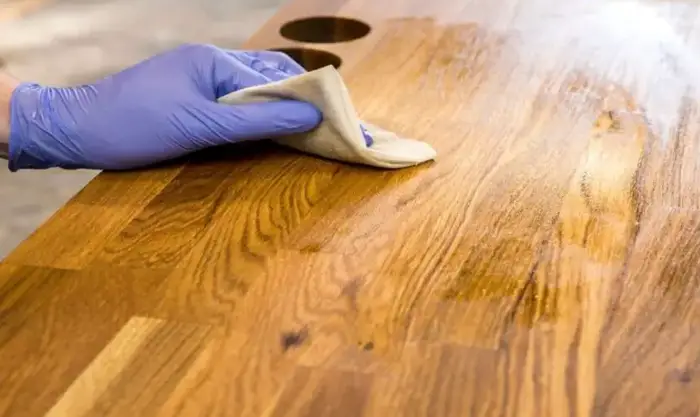
Step 6: Preparing Surface For the Next Coating
You should again prepare the surface for re-applying. Sand the dried surface with 120-grit sandpaper. It will make the surface prepared for the next step. Many people suggest not following this step after the first coating. They suggest sanding the surface after a second or third coating.
But there is no problem with sanding after the first coating. Moreover, this process can remove bubbles formed after using polyurethane. Also, dirt may fall on the surface by mistake. So it will be wise to follow this step after the first coating.
Step 7: Sufficient Coating
Now apply another coat on the surface. At least two or three coats are required for good protection. Without giving sufficient coating, the wood will not be protected enough from water, chemicals, or oil. Let the surface rest again after application, and follow the steps to apply again.
By following these steps, you can easily apply polyurethane with a rag on wooden surfaces.
Tips For Applying Water-Based Polyurethane
You can follow the same process to apply water-based polyurethane. But you have to remember several things while working with water-based polyurethane.
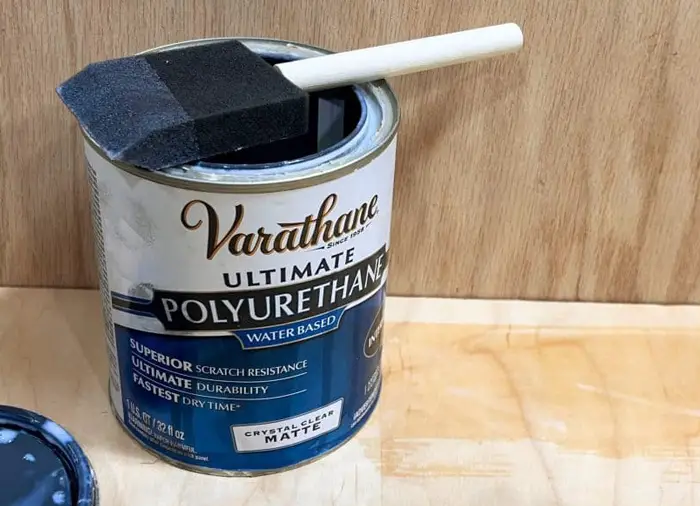
- You should not mix any other substances, like spirit, with water-based polyurethane. Because they come in a prepared form.
- Stir the polyurethane properly before applying it until the solution comes in a homogenous look.
- Never leave the surface with less than three coatings.
- You need to wait at least two hours before applying another coat.
- It is wise to give only two coatings a day.
- The cheesecloth will be the best rag for applying this polyurethane.
- Use an unused rag in every application or removal of excess polyurethane.
FAQs
These are some commonly asked questions by people about polyurethane.
Is it better to apply polyurethane with a brush or rag?
It is better to apply polyurethane with a rag. Because a rag absorbs less polyurethane than a brush. Also, brushes can leave marks on the surface. For beginners, wiping with a rag can be the easiest way.
Can you apply polyurethane with a paper towel?
You should not apply polyurethane with a paper towel. Paper can get stuck on the surface while it is wet. So, that can not make a great finish. Moreover, paper towels are likely to tear while working.
What is the best tool to apply polyurethane?
A roller is the best tool to apply both oil-based and water-based polyurethane. It can equally distribute polyurethane on the surface. Also, there is less chance of wiping excess polyurethane with it.
Conclusion
While coating the surface with a rag, you have to be conscious of the quality of the rag. A well finishing, more or less depending on its quality. Also, using one rag several times is not a good idea. Sand the surface for a smooth finish.
Applying an adequate ratio and proper amount of polyurethane is also important for better outcomes. Fix the irregular bubbles with sandpaper. Give the surface proper time for drying. Compromising with any of these factors can affect the process. Ultimately, you will get a defective coating.

